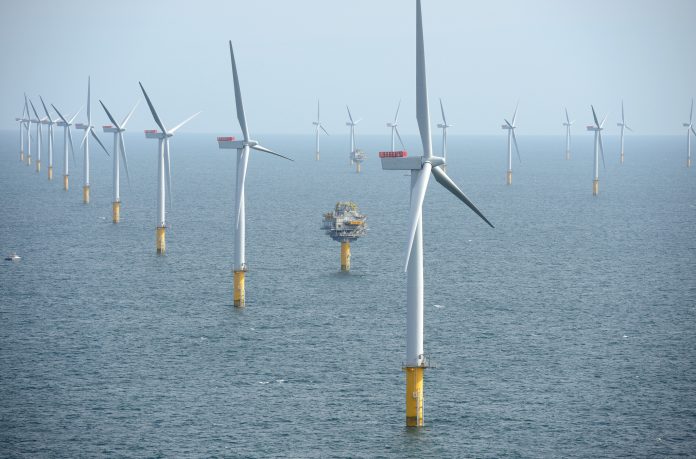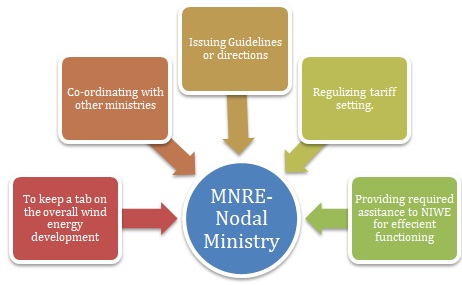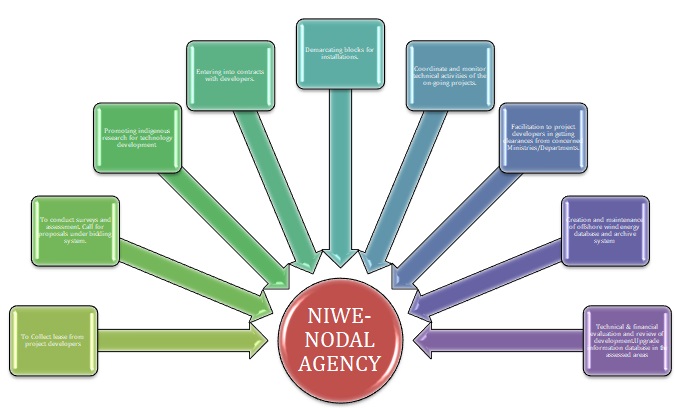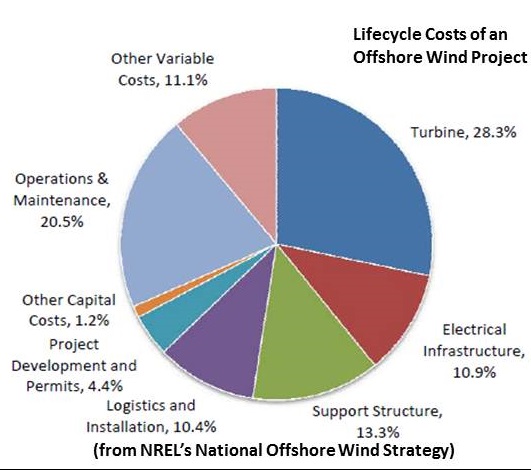In this article, Ambika Kajal pursuing Diploma in Entrepreneurship Administration and Business Laws from NUJS, Kolkata, discusses the National Offshore Wind Policy, 2015.
INTRODUCTION TO THE NATIONAL OFFSHORE WIND ENERGY POLICY
On 9th September 2015, the Cabinet gave its nod in affirmation for the National Offshore Wind Energy Policy, 2015 with the intention to encourage and incentivise the development of offshore wind energy. The Policy was made available to the public for review, by the Ministry of New and Renewable Energy on October 1, 2015, and has come into force from the date of notification in the Official Gazette.
VISION BEHIND THE NATIONAL OFFSHORE WIND ENERGY POLICY
The policy works towards India’s objective of reaching the goal of saving the climate by switching to renewable energy resources. India has already attained the aim of more than 22 GW of onshore wind energy generation.
In consonance with the mandate and responsibility, the Government plans to give a boost to the offshore wind energy sector by updating the technology and the laws dealing with the set up of offshore wind farms.
‘Renewable energy resources’ are essential elements of the Government’s National Action Plan on Climate Change(NAPCC) announced in the year 2008.
Electricity demands will be met sustainably. Coal and other nonrenewable energy resources have harmful effects on the environment as well as the health of people at large.
OBJECTIVES OF 2015 POLICY:
The Indian Government in its concern to promote Offshore Wind Farm has planned to structure a policy that will enable optimum exploitation of areas or zones which are suitable for offshore wind energy farms and in the best interest of the country and to attain the following purposes:[1]
- To Explore and Promote setting up of Offshore Wind Farms in the Exclusive Economic Zone (EEZ) of the nation, including the (PPP) Public Private Partnership in ideal coastal regions.
- To raise financial investment in the Energy Infrastructure which will lead to the deployment of offshore wind farms to harness the wind.
- To provide incentives to private players of our nation as well as multinational giants of other countries to invest and build farms.Thereby, promoting spatial planning as well as the management of maritime renewable resources.
- To achieve electricity as well as energy security for our nation.
- To reduce carbon emissions by switching to offshore wind energy farms for harnessing the wind to generate electricity on a large scale.
- To advance the indigenization of the Energy Technology.
- To promote research and development in the Energy Sector by providing aid and assistance to organizations.
- To create super skilled man force and to generate employment in the wind energy sector.
- To facilitate the development of Project EPC ( Engineering, Procurement, and Construction ) and Operation & Maintenance with regard to the offshore wind industry.
- To develop as well as maintain the coastal infrastructure and supply chain to support heavy construction & fabrication work and the Operation & Maintenance activities in the offshore wind energy sector.
IDEAL DEVELOPMENTAL AREAS FOR OFFSHORE WIND FARMS IN INDIA
Preliminary assessments along the coastline have suggested some prospects of development of offshore wind power. Wind Energy Resource Date collected from the coastline of Rameshwaram, Kanyakumari in Tamil Nadu and Gujarat Coast shows reasonable potential for offshore wind farms. It suggests potential to establish around 1 GW capacity wind farm each along their coastline.
GEOGRAPHICAL COVERAGE
MARITIME ZONES: There are two main marine areas in which structures such as offshore wind farms can be built:
- Indian territorial waters, up to 12 nautical miles (nm) from the baseline; and
- Exclusive Economic Zone (EEZ), beyond the 12 nm limit and up to 200 nm, where under the international law ( United National Conference on Law of Seas), India has right to construct structures such as wind farm installations.
ESSENTIAL ELEMENTS OF DEVELOPMENT OF WIND ENERGY FARM
The components of a policy for the development of offshore wind farm will contain:[2]
- Preliminary Resource Assessment for estimating the potential quotient and preliminary oceanographic & bathymetric studies for demarcation of blocks for installations.
- Environment Impact Assessment and study of proposed Offshore Wind Farms regarding aquatic life etc., studies concerning navigation, undersea mining and related exploitation activities and other users of the sea/marine life.)
- Comprehensive studies & surveys – These studies will determine the construction costs for special foundations, special ships for both operation and maintenance requirements.
- Sea Bed Lease Arrangement.
- Statutory Clearances and NOCs which are required for setting up the farm and are obtained from concerned ministeries of climate change, defence, etc.
- Grid Connectivity and Evacuation of Power (both offshore and onshore)
- Updated Technology concerning the installations.
- Various incentives such as fiscal and financial etc
- Security of offshore installations and confidentiality of the data collected during studies as well as surveys of the same.
- Financing and Insurance.[3]
NODAL MINISTRY and NODAL AGENCY
The Ministry of New & Renewable Energy (MNRE) has been authorized as the Nodal Ministry for use of offshore areas within the Exclusive Economic Zone (EEZ) of the country and the National Institute of Wind Energy (NIWE) has been authorized as the Nodal Agency for development of offshore wind energy. Government has paved way for development of the offshore wind farms up to the seaward distance of 200 Nautical Miles (within its Exclusive Economic Zone) from the base line.[4]
FUNCTIONS OF THE MINISTRY AND NODAL AGENCY ARE AS FOLLOWS
KEY POINTS OF THE 2015 POLICY :
- International Competitive Bidding:
- National Institute for Wind Energy will assign the blocks to the project developers with the assistance of an open and unbiased international competitive bidding process. It is clearly mentioned in the Policy that due to the reason of national security, the National Institute shall have the permission to refuse participation of entities .
- NIWE has the right not to provide any explanation mentioning specific details to the concerned entity on being questioned about the cancellation. The basis of selection of project developers through the process, ranges from the tariff, total cost of proposed project, sharing of production benefits, the rate of lease of land, etc.
- Facilitator of Clearances and Intermediate Off-taker:
- A single window clearance agency, the NIWE has been authorized for the facilitation of prerequisite clearances for project developers to start working on their proposed projects. NIWE has also been given the responsibility for intermediate off-take of energy from the offshore wind energy project in order to thereafter sell it to various state utilities and distribution licensees so as to integrate it with the national grid.
- The notification of blocks by the NIWE depends on clearances from various ministries such as
- Defence,
- Home, as well as
- External Affairs, also
- Environment & Forests and
- The Department of Space.
- Then, Developers would have to obtain clearances from various Ministries of State Governments, which will be facilitated by the National Institute.
- The Policy distinguishes requirements of different approvals and clearances for the clarity of project developers into two stages. A schedule for such clearances shall be issued by MNRE.
- The wide framework of the power purchase agreement (PPA) to be entered into between National Institute of wind Energy and the developer would be the time frame for the commissioning of the project , period of the agreement, commitment to minimum works program in terms of project capacity, monitoring and inspection by MNRE and/or NIWE and the specific decommissioning program.[5]
- The allocation as well as the lease will stand renounced if the project developer fails to commence commercial operations by a particular time frame.
- Costs regarding the farms:
- The Policy has enumerated various challenges to successful deployment of offshore wind power such as proper resource characterization, turbine foundation, installation of turbines, interconnection with utilities and coastal security, etc.
- Such challenges and issues would elevate or increase the cost of the project for the developers in comparison to other renewable energy and conventional energy generation projects; like that of water or solar projects. It will impact the end costs of the consumer. Thus, It requires larger incentives and better subsidies from the government to become competitive and a viable option to choose for the developers.
- Further, proper adjustments to the renewable energy certificate apparatus and regulations determining the renewable energy purchase obligations are needed to support and incentivize the development of offshore wind energy in India.
- The draft of the Policy which was released in 2013, had expressly laid out fiscal incentives like tax holidays and exemption from customs duty and also excise duty, service taxes to attract investments from around the world.
- The Policy, however, provides a blanket clause, stating that all incentives whether fiscal or financial, will be available to onshore wind energy projects. Also, other exemptions and relaxations and generation based incentives would be available to developers of offshore wind energy projects.
- Similarly, bundling of power from offshore wind energy farms with conventional power has been provided. This will assist the development and promotion of offshore wind energy throughout the country.
- Environmental Aspects Concerning the Farms:
- Surveys and comprehensive studies have to be undertaken, including (EIA) Environmental Impact Assessment, Environmental audit, etc., before delimiting the blocks of offshore wind energy farms.
- Surveys can be conducted by only those entities with credible track-record and expertise in the concerned field. NIWE, from time to time, will issue guidelines and release them in public domain, on the undertaking of surveys. The guidelines have to be followed by such entities. Several clearances from the Ministry of Defence have to be obtained as a prerequisite to conducting such surveys and studies.
- The project developer has to submit a comprehensive decommissioning program and site restoration plan before starting the construction work. The project developer has to submit a security deposit or offer a financial guarantee to ensure proper decommissioning of the wind farm. Programs require clearances from the various ministries like that of Environment, Forests and Climate Change.
- Security of the installations:
- The developer will be accountable for the security of the offshore wind energy project. The Policy has not laid down any rules or regulations to be followed by the project developer for ensuring the security of the installations. Vulnerability assessments will have to be conducted by the project developer it regular intervals. The project developer also has to obtain comprehensive insurance cover for such installations.
- A nodal agency (Headquarter,Offshore Defence Advisory Group) will give suggestions to MNRE and/or NIWE about planning and critical policy aspects of offshore security and defense within territorial waters of India and the EEZ.
- The (DGoS) Directorate General of Shipping in consultation with the MNRE shall declare the offshore wind farm as a ‘Restricted Area.’
ADVANTAGES: USHERING GREEN REVOLUTION
Offshore wind speeds tend to be faster than on land. Small increases in wind speed yield large increases in energy production. Faster wind speeds offshore means much more energy can be generated. [7]With the help of this policy , India will be able to harness the offshore winds in the best interest of the nation.
Offshore wind speeds tend to be steadier than on land. A steadier supply of wind means a more reliable source of energy.Many coastal areas have very high electricity needs. India has a large coastline.Building offshore wind farms in these areas can help to meet those energy needs from nearby sources.
Offshore wind farms will create jobs; and they do not emit environmental pollutants or greenhouse gases. The workers will not get affected by any dangerous disease as compared to the workers working in coal set ups and petroleum refineries . Promotion of the offshore wind energy farms will provide the country with a sustainable source of electricity.
CRITICAL ANALYSIS:
The significant challenges which need to be addressed in offshore wind power deployment are:
- Resource characterization,
- subsea cabling,
- the foundation of the turbine,
- installation of turbines ( logistics, grid interconnection and operation)
- development of transmission infrastructure and
- coastal security for the wind farms during construction as well as operation period.
Further, adding large capacities of offshore wind generation to the power system would also require reliable integration to the national grid so that there is no heavy loss of electricity during transmission.
Very high winds, particularly during heavy storms or hurricanes, can damage wind turbine
Effects of offshore wind farms on marine animals as well as birds are not fully understood. Studies are still being undertaken.
Offshore wind farms built within the view of the coastline (up to 26 miles offshore) may be unpopular among local residents, and may have an effect on tourism and also on property valuation.
Deep sea wind farms come with the challenges of assigning no-go areas for commercial shipping. There would be a need to devise new lanes, proper lightning for ships to pass on.Policy is silent about this and there is no notification regarding the same from the Nodal ministry or the agency.
CONCLUSION:
The policy will set an example for other developing nations to work on harnessing renewable resources than the non renewable resources to reach the goal of development. This policy will work towards saving our environment from pollution by promoting offshore wind energy farms. This policy Is a masterpiece of legislation .It will bring fruitful results in the near future. This policy is an evidence that India is ready for green revolution .India is not concerned about development ,instead it is focused on ‘’sustainable development’’.
References
[1]http://mnre.gov.in/file-manager/UserFiles/National-Offshore-Wind-Energy-Policy-Gazzette-notification.pdf (Last visited:30th june,2017)
[2]http://mnre.gov.in/file-manager/UserFiles/National-Offshore-Wind-Energy-Policy-Gazzette-notification.pdf (Last Visited :30th June , 2017)
[3] http://www.governorswindenergycoalition.org/?p=15046 (Last Visited:30th June,2017)
[4] http://www.gktoday.in/blog/national-offshore-wind-power-policy-2015/ (Last Visited: 30th June , 2017)
[5] www.mondaq.com/india/x/441280/Renewables/National+Offshore+Wind+Energy+Policy+2015(Last Visited :30th june , 2017)
[6]https://www.greentechmedia.com/articles/read/nrg-bluewaters-peter-mandelstam-offshore-wind-is-power-near-the-people(Last Visited :30th June 2017)
[7] www.americangeosciences.org/critical-issues/faq/what-are-advantages-and-disadvantages-offshore-wind-farms ( Last Visited : 30th June , 2017)
 Serato DJ Crack 2025Serato DJ PRO Crack
Serato DJ Crack 2025Serato DJ PRO Crack














 Allow notifications
Allow notifications




Nice information provided
[…] India also aims to install 5GW of offshore wind by 2022 and 30GW by 2030. None has yet been installed, however. […]
[…] also aims to install 5GW of offshore wind by 2022 and 30GW by 2030. None has yet been installed, […]
[…] also aims to install 5GW of offshore wind by 2022 and 30GW by 2030. None has yet been installed, […]